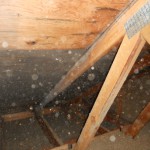Welcome to our comprehensive guide on mold prevention techniques for your home. Mold growth can pose significant health risks and cause structural damage to your property. By implementing proactive measures and addressing common issues that contribute to mold growth, homeowners can create a healthier and mold-free living environment for their families. In this guide, we’ll cover essential strategies to prevent mold in your home, including addressing negative grading, maintaining proper guttering systems, preventing sump pump failure, caulking around windows and doors, ensuring proper ventilation, and more.
Address Negative Grading
Consequences:
Water pooling around the foundation can lead to moisture infiltration, weakening of the foundation, and mold growth in basements and crawl spaces.
Recommendations:
Add soil to create a slope away from the foundation, directing water flow away from the house.
Ensure that landscaping features such as flower beds or mulch are sloped away from the foundation to prevent water from collecting near the house.


Maintain Proper Guttering Systems
Consequences
Clogged gutters, insufficient downspouts, or missing extensions can cause water to overflow and seep into the foundation or basement, leading to water damage and mold growth.
Recommendations
Regularly clean gutters to remove leaves, debris, and other obstructions.
Ensure downspouts extend at least six feet away from the foundation to redirect water away from the house.
Install gutter guards to prevent debris buildup and reduce the frequency of gutter cleaning.


Prevent Sump Pump Failure
Consequences
Sump pump failure due to power outages, mechanical issues, or overwhelming water volume can result in water accumulation in basements and crawl spaces, leading to water damage and mold growth.
Recommendations
Install a battery-powered backup sump pump or water pressure backup system to ensure continuous operation during emergencies.
Test the sump pump regularly and replace it if it shows signs of wear or malfunction.
Consider installing an alarm system to alert you to sump pump failures or high water levels.


Seal Caulking Around Windows and Doors
Consequences
Improper caulking around windows and doors can result in water intrusion, air leaks, and moisture buildup, leading to mold growth and energy inefficiency.
Recommendations
Inspect caulking around windows and doors regularly and reapply as needed to maintain a watertight seal.
Use high-quality silicone or acrylic caulking designed for exterior use to ensure durability and weather resistance.
Address any gaps or cracks promptly to prevent water infiltration and air leaks.


Ensure Proper Ventilation
Consequences
Inadequate ventilation in living areas and attics can lead to moisture buildup, condensation, and mold growth, especially in cold climates.
Recommendations
Install exhaust fans in bathrooms, kitchens, and laundry rooms to remove excess moisture and odors.
Consider adding attic ventilation, such as ridge vents or attic fans, to promote air circulation and prevent moisture buildup.
Use insulated ductwork for exhaust fans to prevent condensation in cold climates.


Address Plumbing and Roof Leaks Promptly
Consequences
Plumbing leaks and roof leaks can introduce moisture into your home, leading to water damage, structural issues, and mold growth.
Recommendations
Regularly inspect plumbing fixtures, pipes, and roofing for leaks, stains, or signs of water damage.
Repair any leaks or damaged components promptly to prevent further water infiltration and mold growth.
Consider hiring a professional plumber or roofer for thorough inspections and repairs.


Control Indoor Humidity Levels
Consequences
High indoor humidity levels can promote mold growth and exacerbate respiratory issues, allergies, and asthma.
Recommendations
Use dehumidifiers in areas prone to moisture buildup, such as basements, bathrooms, and crawl spaces, to maintain indoor humidity levels between 30% and 50%.
Ensure proper ventilation in high-humidity areas to allow moisture to escape and prevent condensation.
Use exhaust fans or open windows when cooking, showering, or doing laundry to reduce indoor humidity levels.

Prevent Condensation
Consequences
Condensation on windows, pipes, and walls can lead to moisture buildup, water damage, and mold growth, especially in cold climates.
Recommendations
Improve insulation in walls, ceilings, and windows to reduce temperature differentials and minimize condensation.
Increase ventilation in areas prone to condensation, such as bathrooms, kitchens, and laundry rooms, to promote air circulation and moisture removal.
Use moisture-absorbent materials, such as silica gel or activated charcoal, in enclosed spaces to reduce humidity levels and prevent condensation buildup.
By addressing these common issues and following the recommended strategies, homeowners can effectively prevent mold growth and maintain a healthy and mold-free living environment. Regular maintenance, proactive measures, and prompt repairs are essential for protecting your home against the detrimental effects of mold.
